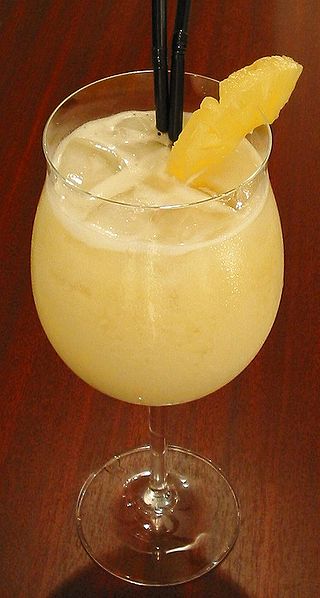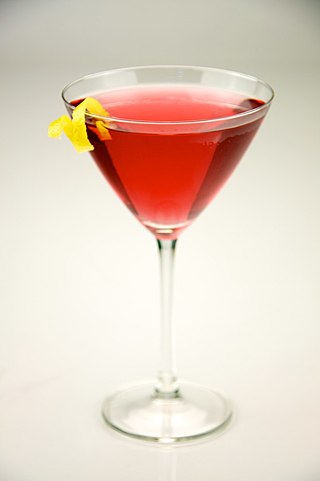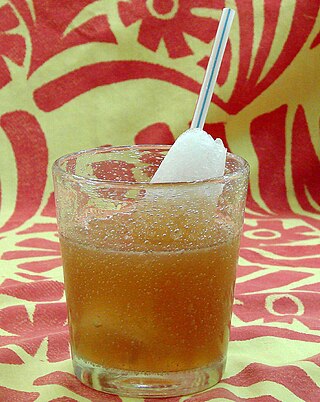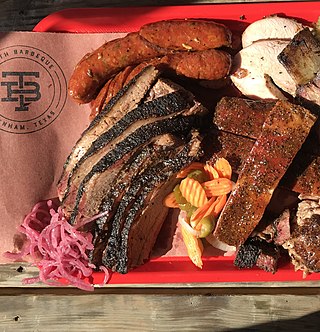
The Piña Colada is a cocktail made with rum, cream of coconut, and pineapple juice, usually served either blended or shaken with ice. It may be garnished with either a pineapple wedge, maraschino cherry, or both. The drink originated in Puerto Rico.

Tex-Mex cuisine is a regional American cuisine that originates from the culinary creations of Tejano people. It has spread from border states such as Texas and others in the Southwestern United States to the rest of the country. It is a subtype of Southwestern cuisine found in the American Southwest.

A margarita is a cocktail consisting of tequila, triple sec, and lime juice. Some margarita recipes include simple syrup as well and are often served with salt on the rim of the glass. Margaritas can be served either shaken with ice, without ice, or blended with ice. Most bars serve margaritas in a stepped-diameter variant of a cocktail glass or champagne coupe called a margarita glass. The margarita is one of the world's most popular cocktails and the most popular tequila-based cocktail.

A milkshake is a sweet beverage made by blending milk, ice cream, and flavorings or sweeteners such as butterscotch, caramel sauce, chocolate syrup, or fruit syrup into a thick, sweet, cold mixture. It may also be made using a base made from non-dairy products, including plant milks such as almond milk, coconut milk, or soy milk. Dry ingredients such as whole fruit, nuts, seeds, candy, or cookies may be incorporated.

The daiquiri is a cocktail whose main ingredients are rum, citrus juice, and sugar or other sweetener.

A cosmopolitan, or, informally, a cosmo, is a cocktail made with vodka, Cointreau, cranberry juice, and freshly squeezed or sweetened lime juice.

Lemonade is a sweetened lemon-flavored drink.
Tajín Clásico, often referred to as simply Tajín, is a Mexican spice mix consisting predominantly of lime, chili peppers and salt. It is used in a variety of preparations.

A slushy is a type of beverage made of flavored ice and a drink, similar to granitas but with a more liquid composition. It is also commonly called a slush, slurpee, frozen beverage, or frozen drink. A slushie can either be carbonated or non-carbonated; the carbonated version is sometimes called a frozen carbonated drink or frozen carbonated beverage.
The Cojito is a sweet cocktail made with lime and mint, and typically rum and coconut. It is a variant of the mojito, but typically adds coconut flavor. This can be done by adding coconut milk or coconut-flavored liqueurs, or by using coconut-flavored rum such as Blue Chair Bay, Cruzan coconut, or Malibu. Coconut on the rim of the cocktail glass may also be used. The use of coconut rum gives the Cojito a more "tropical" taste than the mojito. The strong minty taste may lead some to adjust downward the quantity of fresh mint leaves used.

The Navy Grog was a popular rum-based drink served for many years at the Polynesian-themed Don the Beachcomber restaurants; it is still served in many tiki restaurants and bars. First created by Donn Beach, who almost single-handedly originated the tiki cultural fad of the 1940s and 1950s, it was one of dozens of rum concoctions that he, and later Trader Vic and numerous other imitators, sold in exotic tropical settings. Not quite as potent as the Beachcomber's more famous Zombie, it was, nevertheless, shown on the menu as being limited to two, or sometimes three, to a customer. Reportedly, Phil Spector consumed at least two Trader Vic’s Navy Grogs at the Beverly Hilton restaurant, without eating any food, the night he later killed actress Lana Clarkson.

Texan cuisine is the food associated with the Southern U.S. state of Texas, including its native Southwestern cuisine–influenced Tex-Mex foods. Texas is a large state, and its cuisine has been influenced by a wide range of cultures, including Tejano/Mexican, Native American, Creole/Cajun, African-American, German, Czech, Southern and other European American groups. The cuisine of neighboring states also influences Texan cuisine, such as New Mexican cuisine and Louisiana Creole cuisine. This can be seen in the widespread usage of New Mexico chiles, Cayenne peppers, and Tabasco sauce in Texan cooking.
Maggie Rita's Tex-Mex Grill & Bar is a Tex-Mex restaurant in Houston. For several years, Maggie Rita's was a restaurant chain with a license co-owned by Carlos Mencia and Santiago Moreno of Suave Restaurant. In January 2013, Moreno closed the last two locations they owned. Tony Shannard owns the only remaining Maggie Rita's restaurant, which is situated in Houston's JPMorgan Chase Tower.
Mariano Martinez is an American inventor, entrepreneur, restaurateur, and creative artist. In Dallas, Texas, in 1971, he adapted a slurpee machine to making margaritas and dubbed it "The World’s First Frozen Margarita Machine". That machine is now in the collection of the National Museum of American History, part of the Smithsonian Institution.

Esparza's Tex Mex Cafe, or simply Esparza's, was a Tex-Mex restaurant in Portland, Oregon, in the United States. Opened by Martha and Joe Esparza in 1990, the restaurant operated for more than 24 years before closing in January 2014. Its unusual menu included buffalo tostadas, ground ostrich and nopalitos, several varieties of tongue, beef brisket, and more traditional options such as enchiladas, quesadillas, tacos and tamales. Esparza's was one of Portland's most popular restaurants during the 1990s and was named "Restaurant of the Year" by The Oregonian in 1992.

The Goose, formerly The Blue Goose, was a New Mexican, Southwestern, and Tex-Mex restaurant in southeast Portland, Oregon, United States.

Nacho Borracho is a bar and Mexican/Tex-Mex restaurant in Seattle, in the U.S. state of Washington.
Mi Cocina is a Tex-Mex restaurant.














